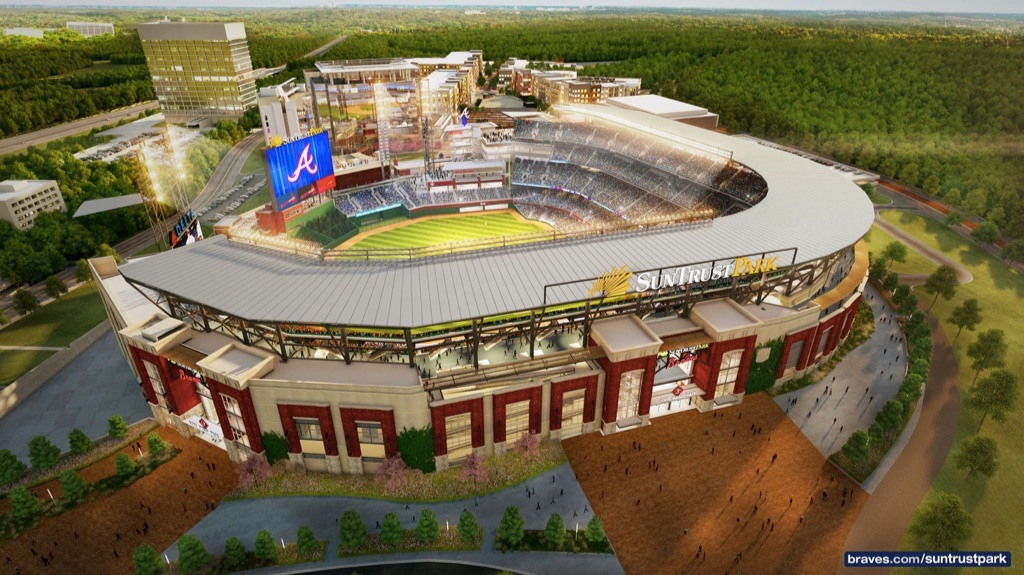With today’s opening of SunTrust Park, the Atlanta Braves are showcasing a new ballpark that combines a traditional look with the high-tech goodies fans expect, all nestled in an ambitious mixed-use development.
Generating development has been a holy grail for baseball teams when pitching new ballparks, and SunTrust Park fits squarely in this philosophy. Besides the ballpark, the SunTrust Park area includes 1.5 million square feet of development in the general area, with a mixed-use development that includes office space (with tenants like Comcast already in place), 531 apartments, a high-end Omni Hotel and more. That’s the challenge on the master planning front: to combine a highly accessible ballpark with a mixed-use development. Why highly accessible? Because the Braves had set out a goal to use parts of the ballpark on non-game days, according to Zach Allee, Populous Senior Associate.
That means social spaces in the ballpark not only had to serve the needs of game-day attendees as well as the needs of folks attending an offseason concert. That alone is a challenge when you’re looking at 1.5M SF of development that includes taller office buildings. Add in a restaurant/bar development, and you have multiple uses posing multiple challenges.
“In the past we’ve done planning of small portions around the ballpark, but certainly nothing at that magnitude,” Allee said. “This was a big opportunity, and that’s what we focused on with the master planning.”
On the design side, that meant a different approach to planning. Every recent MLB project in the last decade—Target Field, Marlins Park, Yankee Stadium, Citi Field, Nationals Park, Busch Stadium—has been built in an urban environment. With SunTrust Park, MLB is returning to the suburbs, albeit on a site that doesn’t feature the sea of parking you formerly found surrounding the likes of Qualcomm Stadium.
“It presents a different kind of opportunity for what the architecture can be,” Allee said. “It frees you up, which can be harder.”
The process meant dealing with some of the site quirks. The design team needed to work around a gas pipeline, as well as a topography that drops 100 feet from one end to the other. Because the Braves wanted fans to view the skyline, the ballpark orientation is decidedly not traditional, providing a southeastern view. (Players, however, won’t be looking into the sun while fielding their positions; it’s not a true south orientation a la Comerica Park.) The sun isn’t expected to be a major factor at all in the ballpark: the huge canopy will cover much of the seating, and the office buildings will provide some shade as well.
Those considerations led to a five-deck design with different access points at different levels. The ballpark cuts back into a rocky hill, where fans will enter at midlevel and then walk down. (Ballparks will recognize the similarity to Dodger Stadium, where the ballpark was built into the Chavez Ravine hillside.) The relatively tight site led to a design that’s higher than the average MLB ballpark, with fans closer to the action than they were at Turner Field. In fact, the last seat in the upper deck is 21 feet closer than what it was at Turner.
As noted, the design will combine the traditional with the modern. The emphasis, according to Allee, is on warm materials like brick in a Southern vernacular. “For the Braves, there was a definite feeling about a traditional use as the longest active franchise in baseball,” Allee says. “We were tasked with creating a traditional Southern feel with all of the modern amenities.”
That includes the large steel canopy. That includes a dual 100-gigabit internet bandwidth installation for a total of 200 gigabits. That’s enough bandwidth to serve everyone in the 41,149 –capacity ballpark via 800 WiFi hot spots. Over 25 miles of fiber-optic cable runs through the ballpark and the surrounding area.
The high-tech LED lights on the canopy will also be illuminating for fans. There’s no warm-up time: they’re instantly at full capacity. The lights can change color depending on circumstances: wins, losses, home runs, etc. And four center-field water cannons will also mark homers.
For Allee, a spot fans should seek out has little to do with technology and everything to do with Braves history: the Monument Garden in Section 125, a landscaped area just off the concourse. The team’s history museum at Turner Field wasn’t replicated in SunTrust Park, but the contents are installed throughout the ballpark. A new Henry Aaron statue is in Monument Garden, as well as plaques honoring the 31 Braves Hall of Fame inductees.
This wraps up our series of articles on the opening of SunTrust Park. In case you missed the previous articles, here are links:
SunTrust Park Takes Southern Hospitality to New Heights
SunTrust Park Preview: Social Spaces
SunTrust Park Preview: Down-Home Cooking

